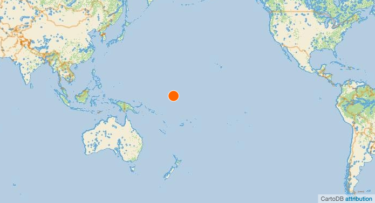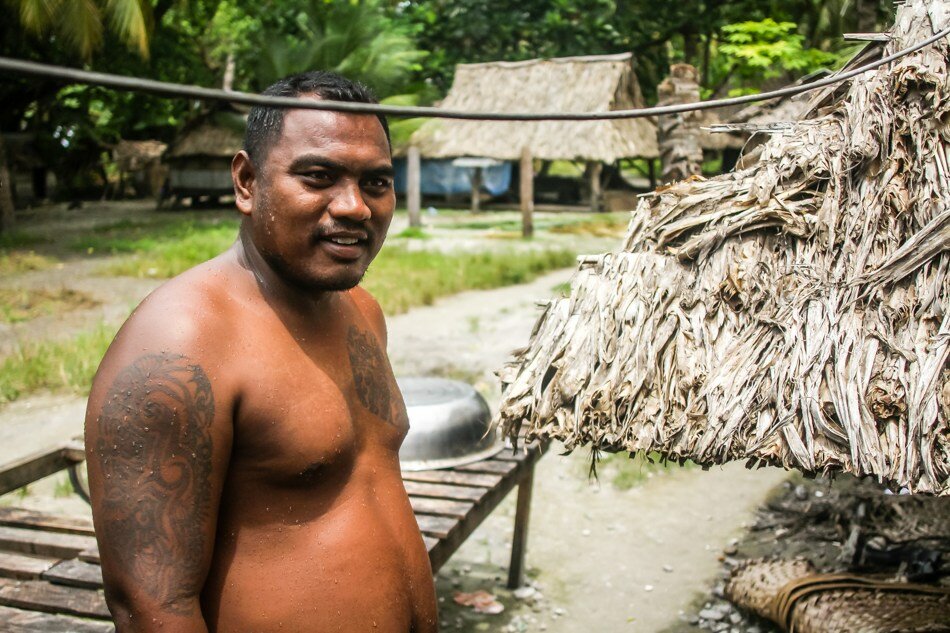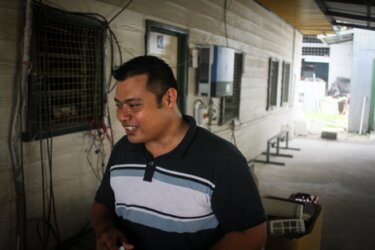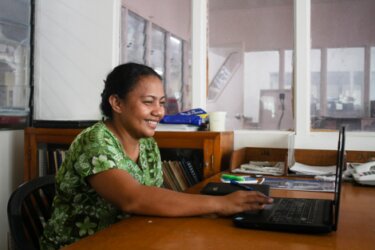Why the South Pacific island Kiribati is making a big bet on solar
Poverty-stricken and energy-poor, the remote South Pacific island nation of Kiribati is embracing solar energy. Is its experience a model or a cautionary tale?
Search all Discourse content.
Close
Follow our reporting and get involved. Sign up for our newsletter.
Close
Poverty-stricken and energy-poor, the remote South Pacific island nation of Kiribati is embracing solar energy. Is its experience a model or a cautionary tale?
Poverty-stricken and energy-poor, the remote South Pacific island nation of Kiribati is embracing solar energy. Is its experience a model or a cautionary tale?
Mike Ives | April 19, 2016

Source: World Bank
BUARIKI, KIRIBATI — As late as 1990, nightfall in Kiribati (pronounced “Kiribass”), a patchwork of tiny islands in the middle of the Pacific Ocean, was accompanied by a peculiar odor. More than 60 per cent of the country’s 103,000 people had no electricity, and whenever dusk fell, many of them would light greasy kerosene lamps in order to see.
The kerosene fumes were unavoidable, villagers recalled, and the light was not quite suitable for weaving or reef fishing — two economic activities that are central to village livelihoods. “Uncomfortable and annoying,” recalled Roniti Piripi, a villager on North Tarawa, a two-hour boat ride from the grid-connected capital in South Tarawa.
But in 1991, an agent from a government company came to his village, Buariki, and offered to lease him a solar home system for a one-time payment of US$52 and regular monthly payments of $7. Piripi said he leapt at the opportunity and hasn’t looked back. The solar system that he leased 25 years ago now powers his family’s home and dry-goods shop on Buariki’s unpaved main street. They also have a second solar panel from the energy company, which they purchased for around $170, and several hand-held solar lights (donated to 10,000 Kiribati households last year by the Taiwanese government).

“Once we got solar energy, everything was easy,” Piripi’s wife, Taanti Kaitangare, recalled as she sat in a thatch-roofed, open-air meeting space, known as a maneaba. “We’re so much happier.”
Since 1991, the state-owned Kiribati Solar Energy Company (KSEC) has distributed approximately 4,400 home solar systems across 21 of the country’s 33 islands and received millions of dollars in development assistance from Japan and then the European Union, according to Tavita Airam, the company’s chief executive.

Villagers in off-grid areas are “really happy because women can do the weaving, and men can go out fishing, using the lights,” he said recently in his office, a squat residential building in South Tarawa, near the country’s only industrial seaport.
But the 25-year solar rollout in Kiribati hasn’t always gone smoothly, according to officials and energy consultants. Airam also concedes that KSEC’s US$75,000 maintenance fund for its solar equipment is underfunded by half, and that with EU assistance scheduled to formally end in March, the company’s long-term growth strategy will depend on the government’s willingness to subsidize it.
Kiribati’s energy story highlights both the successes and pitfalls of off-grid solar projects in the South Pacific, a region that includes some of the world’s poorest countries. On one hand, energy experts say such initiatives have brought power to thousands of remote villages despite enormous geographic and logistical obstacles. But they add that the region’s solar programs, which are typically funded by international donors, have been plagued by bureaucratic inefficiency and a chronic lack of attention to long-term economic and technical sustainability.
"Systems are installed, and then what? The batteries fail, and after five or six years people want to replace them — but no one has money set aside."
Peter Konings, chief executive of Asia-Pacific Energy GroupA typical South Pacific scenario goes something like this: A solar program gets off to a bright, promising start, but burns out after millions in donor funding have been spent. National utilities eventually lose interest in providing solar systems, while technicians lack technical capacity to fix them. The poorest and most isolated villagers can’t afford to buy them or pay for repairs. The systems deteriorate until another set of donors comes to the rescue — at least for the time being.
“Systems are installed, and then what? The batteries fail, and after five or six years people want to replace them — but no one has money set aside,” said Peter Konings, chief executive of Asia-Pacific Energy Group, an American energy company that operates across Asia, Europe and Africa and specializes in off-grid solar development.
“You want to do a good job, but basically you’re putting solar systems in places where there’s no cash economy,” he continued. “There’s no monthly income, so how can they make monthly payments?”
When a passenger jet approaches South Tarawa, Kiribati’s most populous island, at the end of a three-hour flight from Fiji, one wonders where it can possibly land. That is because most of the island is only a few dozen metres wide — barely enough room, it seems, for a landing strip.
Kiribati’s 33 islands are spread across 3.5 million square kilometres of ocean, but the total land mass is about half the size of greater London. The two-hour boat ride across an ocean lagoon from South to North Tarawa is short by local standards; Airam said it can take nearly two weeks to ship KSEC solar equipment from South Tarawa’s port to some of Kiribati’s more remote islands. (He usually flies to site visits.)
The Pacific Ocean has some of the world’s most productive fishing grounds, and fish is a key source of food security in Kiribati and neighbouring countries. Yet the ocean’s vastness also impedes economic development. Pacific Island states are “unique in their remoteness,” even among other small-island developing states, the World Bank reports. Oceania, as the wider region is sometimes called, covers an area roughly the size of the contiguous United States. But its total population, including Australia’s and New Zealand’s, is about 38 million — roughly equivalent to metropolitan Tokyo.
The vast swaths of ocean that separate Pacific Island states from each other, and from the nearest continents, coupled with a lack of fossil-fuel reserves and (for Kiribati and some of its neighbours) arable land for subsistence agriculture, make long boat trips and extensive imports of food, fuel and other essential goods a fact of life. It does not help that the populations of Pacific Island states are highly dispersed, or that the fixtures of the region’s economic life — fishing boats — require a constant flow of gasoline.
All of that makes Pacific Island states especially vulnerable to swings in prices of essential commodities, particularly transportation and cooking fuel. A study by the Asian Development Bank found that, in 2006, fossil fuel — mainly oil — made up 85 per cent of the countries’ total energy mix. If the region’s most populous countries, Fiji and Papua New Guinea, were excluded from that calculation, the rate climbed to 99 per cent. By contrast, the average for the Asia-Pacific region was 45 per cent, and just 34 per cent globally.
The South Pacific’s energy dependence was painfully obvious during the global financial crisis of 2008, when a spike in oil and food prices led to inflation ranging from 2.5 per cent to 12 per cent, according to a recent study, in the journal Resources, by Matthew Dornan, a South Pacific expert at the Australian National University (ANU) in Canberra. In 2009, Pacific island states spent a whopping US$873 million on fuel imports — about three-quarters of it for transportation. Amid the crisis, a group of Pacific energy ministers declared that their economies were “the most vulnerable in the world to rising oil prices.”
"The big issue in the region is that government attention and funds have been directed towards the state-owned power utilities that provide electricity in urban areas."
Matthew Dornan, Australian National UniversityGeographic isolation clearly impedes construction of electricity grids and other energy infrastructure projects on all but the largest South Pacific islands. But Dornan said geography is not the only problem; he also blames the “very regressive” approach that many of the region’s governments take to energy development. “The big issue in the region is that government attention and funds have been directed towards the state-owned power utilities that provide electricity in urban areas,” he said.
“They’ve been provided in such a way to keep electricity prices low for urban households, and that’s an understandable endeavor given the low incomes of many people in these countries,” Dornan added. Yet urban-centric energy policies have also “placed those utilities in a difficult financial position and prevented them from extending their electricity networks. And it’s prevented them from expanding off-grid power supply in rural areas.”
In 2014, Dornan wrote in the journal Renewable and Sustainable Energy Reviews that electrification rates in Vanuatu, Papua New Guinea and the Solomon Islands were in the teens. By that measure, Kiribati, with a 63 per cent electrification rate, looked rather modern. Yet even that rate was less than Britain’s (66 per cent) on the eve of the Second World War.
Many South Pacific governments have turned to off-grid solar power in recent years as a way of reducing their energy dependence in remote areas while improving residents’ standard of living. The approach appears to make sense primarily because off-grid systems require far less investment and engineering than a traditional power grid would.
“It’s a problem of scale,” said Anirudh Singh, a renewable-energy specialist at the University of the South Pacific (USP) in Fiji. “Grid electrification is not feasible; therefore [planners] have to largely resort to stand-alone systems” in rural areas. He added that the push for stand-alone systems began about two decades ago and has intensified as the cost of solar systems has steadily declined.
But infrastructure and geography are not the only motivating factors. According to Dornan, Pacific island states appear to like off-grid programs at least partly because they attract development assistance. Many of the region’s low-lying states also face an existential risk in the form of projected sea-level rises linked to climate change, and Dornan said the region’s leaders may see greening their energy sources as a means of strengthening their negotiating hands at international climate-change negotiations. (Kiribati’s former president, Anote Tong, who stepped down in early March, has been particularly outspoken on the risks that climate change poses to low-lying island nations.)

Three Pacific island states — Niue, Tuvalu and the Cook Islands — have already set the ambitious target of sourcing all their electricity from renewable sources by 2020. Kiribati’s current renewables target is 45 per cent and 60 per cent, respectively, for urban and rural areas. Mwaati Oten, the acting Conventional Energy Planner at the Ministry of Public Works and Utilities, said the government is mulling a proposal to make all of its rural homes and schools fossil fuel-free by 2025.
Tokelau, a tiny New Zealand protectorate, is already producing its electricity entirely from renewables. But it is not a realistic model for the rest of the region, according to USP’s Singh. “It’s an anomaly,” he said, in part because the power comes from a municipal solar array instead of smaller, home-based solar systems.
It turns out that Tokelau, with a population of less than 2,000, has something that other Pacific Island states lack: a concentrated population, and a concentration of households that can be served by a centralized power source. Providing off-grid solar power without a central solar array can be far harder.
“If you want stand-alone [solar systems], the storage is a major issue,” Singh said. “The lifetime of the panels can go up to 20 years, but for the storage batteries, the lifetime is five or six years only. And that is always a major issue.”
Despite the ambitious energy goals and generous development assistance, many of the South Pacific’s off-grid solar projects have produced disappointing results, according to energy consultants with many years of experience in the region.
Among the best documented examples: a program in Fiji to lease home-based solar systems to rural consumers, which began in the late 1980s. ANU’s Dornan said it has been hampered by bureaucratic mismanagement, “perverse” financial incentives and “a lack of interest from successive governments.”
Other Pacific utilities are also struggling to maintain a continuous power supply in off-grid areas while also bringing in steady revenue, said Geoff Stapleton, secretary of the Sustainable Energy Industry Association of the Pacific Islands, a trade association whose members include companies and government departments.
Stapleton said the constant presence of donors in the region is “part of the problem.” He said the flow of overseas money encourages users of new solar systems to think: “ ‘If it breaks down, a donor will come and fix it.’ ”
“That, to me, is one of the biggest stumbling blocks,” he said.
Other solar energy experts say the South Pacific’s typical solar partners — donors and national electric utilities — do not always work in the public interest because their bureaucracies make them less responsive than a private company might be to changing market forces and consumer needs.
Konings, of the Asia-Pacific Energy Group, said it is useful to compare the South Pacific’s off-grid solar market with that of Southeast Asia, a region of more than 600 million people with a higher population density and brisker business culture. Southeast Asia has many private companies producing a wide array of home-based solar products, some of them of poor quality, he explained. But Southeast Asian consumers have choices, and market forces tend to reward good performance.
“In the Pacific, it’s the utilities doing the job, and they are limited in know-how and capacity,” he said.

The Kiribati Solar Energy Company (KSEC) was launched in 1984, under a slightly different name, as a non-profit business funded by the United States Agency for International Development (USAID). Over the next five years, it sold 270 home-based solar systems in rural areas, and larger ones to schools and government agencies, according to a follow-up study by the company’s ex-general manager, Terubentau Akura, and two international consultants.
On paper, the project was working well. But the reality was different, recalled Herbert Wade, a solar energy expert who worked as a United Nations contractor in Kiribati at the time. A big problem, Wade said, was that many customers unintentionally damaged the solar systems through misuse — using telephone wires instead of larger wires to carry current, for example.
“It was just terrible,” Wade said. “It couldn’t possibly work for the long term, and it didn’t.”
By 1989, the company was “effectively bankrupt” amid dwindling sales, according to the follow-up study, and technicians would later discover that around 90 per cent of the initial 270 units “were only marginally operational or not in use at all.” So the government decided to make KSEC a state-owned electrical utility that would lease solar units to consumers for a base deposit and a monthly fee.
The Japan International Cooperation Agency (JICA) sponsored the utility’s first pilot electrification project in North Tarawa with “very favorable results,” according to the follow-up study, and the EU later upscaled the project to about 300 systems. Wade, an author of the study, said the project was working well at that scale.
But in the early 2000s, the EU’s decision to upscale the project to 2,100 solar systems proved too ambitious for the remote country’s limited human and technical resources.
“The government said, ‘Well, with this money we can put some solar on houses on every island,'” Wade recalled.
“It sounds really great in terms of a development project because, boy, we were going from this three-island trial up to the whole country,” he continued. “But what was forgotten was that the solar energy company only had three or four people. And how do you get from taking care of 325 systems on relatively nearby islands, to 2,500 systems spread all over the country? They couldn’t do it.”
Tell us why these stories matter and what you’ll do with this info.
On a recent afternoon, Tavita Airam, KSEC’s chief executive, strolled through his company’s South Tarawa warehouse: a high-ceilinged garage full of panels, batteries, inverters and spare parts for replacing broken equipment. Employees were buzzing in a nearby courtyard. Airam wore shorts and sandals, and he looked relaxed and confident.
KSEC’s fortunes have improved considerably in the last decade, Airam explained. It now has licensed solar engineers working on 21 islands and sends technicians from South Tarawa to monitor solar systems there about twice a year. It has also collected about $75,000 so far in monthly user fees, and stores the money in a rainy-day fund for equipment repair. And it has offered to fix any broken Taiwan solar kits for about $36 — so long as the system owners brings them to South Tarawa.
But his work isn’t problem-free, Airam said. Kiribati’s remote location still makes it difficult to arrange equipment transfers and return damaged or defective equipment to manufacturers, and the rainy-day repair fund is only about half of what it should be to ensure long-term fiscal sustainability. The project has spent at least US$150,000 per year from an EU fund, he added, but now that the EU funding is ending, he intends to ask the government to subsidize equipment repairs and provide seed capital to buy more solar systems. A new government began a four-year term on March 10, and the final decision will be hashed out in the country’s parliament.
But even if the company’s finances stabilize, that will not help many ordinary villagers — especially the poorest ones — to buy home-based solar systems.
“The problem is most of the households cannot afford to buy the system,” Harry Tekaiti, the mayor of North Tarawa, said in an interview.

Bitta Tamoaieta and Boata Tooma, a couple in their mid-forties who live near the mayor, said they once leased a solar system for $36, but KSEC repossessed it seven years later after they defaulted on several $7 monthly payments.
A few years later, Tamoaieta’s brother, who works as a seaman, offered to buy him one, he recalled. But he felt so much bitterness toward the company that he declined. The couple went back to kerosene for a few years, and later received one of the 10,000 solar kits that were distributed for free across Kiribati. Each one says “Love from Taiwan.”
On a recent evening, a forearm-sized light illuminated Tamoaieta and Tooma. They sat in their thatch-covered outdoor kitchen area beside a kerosene stove and a grimy dry-goods cupboard. A diesel generator was humming in a nearby home and the sound — and smell — carried into the couple’s lawn.
Asked what she would do if and when the light broke, Tooma laughed.
“We’ll go back to kerosene again because we don’t have another choice.”
Two billion people lack reliable access to electricity. That means one fifth of the world's schools, hospitals and homes are often in the dark. How can everyone get access to clean energy without hastening climate change?
Power Struggle is a collaboration of journalists around the world who are investigating how energy poverty affects people in their regions — and what solutions are emerging.
Click here to learn more about the latest from our partners at WGSI.
Discourse Media is an independent journalism company dedicated to in-depth reporting on complex issues. We are building a home for new approaches to storytelling that look beyond conflict-driven daily news cycles.
GET INVOLVED
We’d love to hear your stories. How are you impacted by the issues we’re reporting on? What solutions do you see? Who is inspiring you? Get in touch.
WORK WITH US
Learn about our products and services.
© 2016 Discourse Media Inc. Privacy Policy Terms of Use